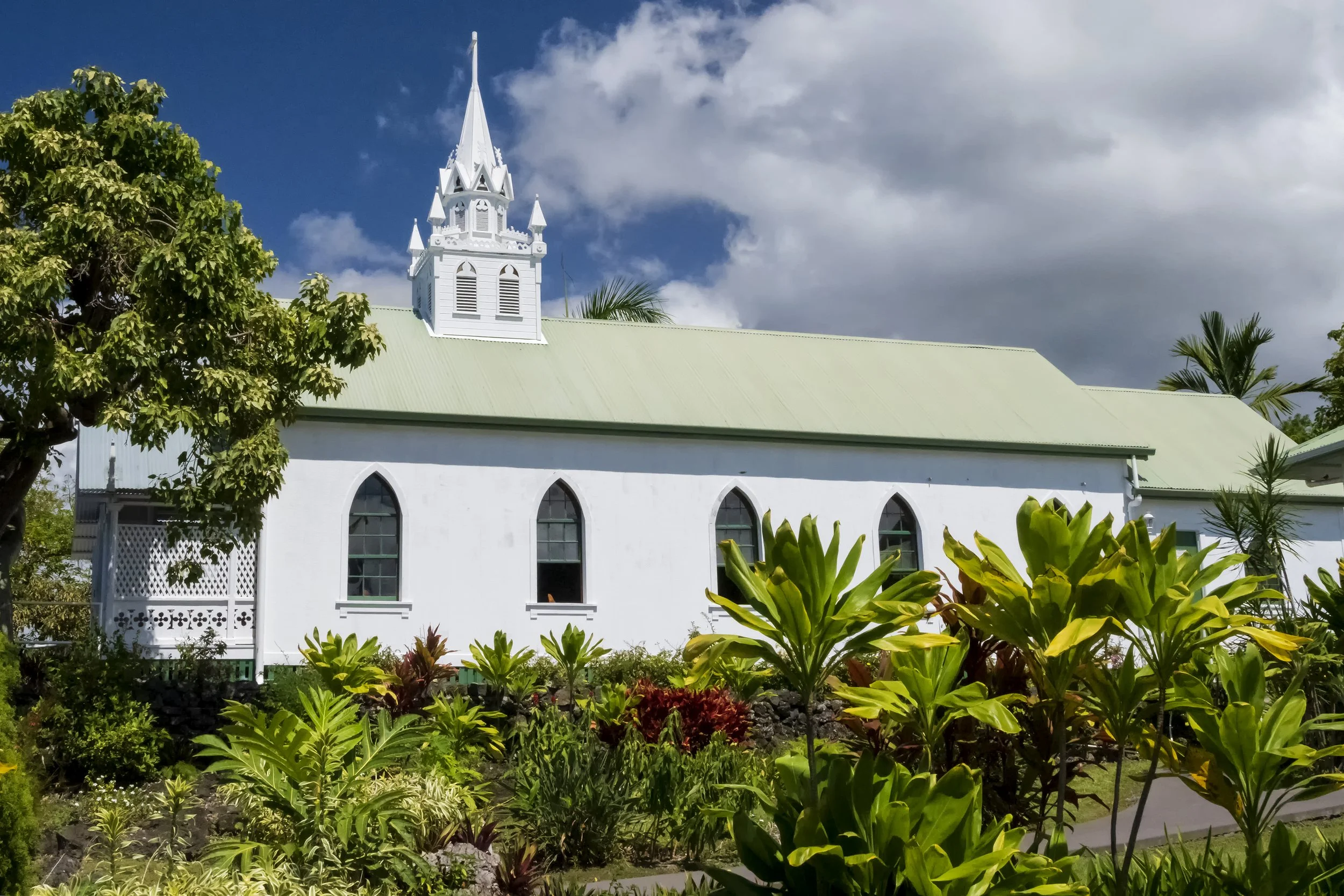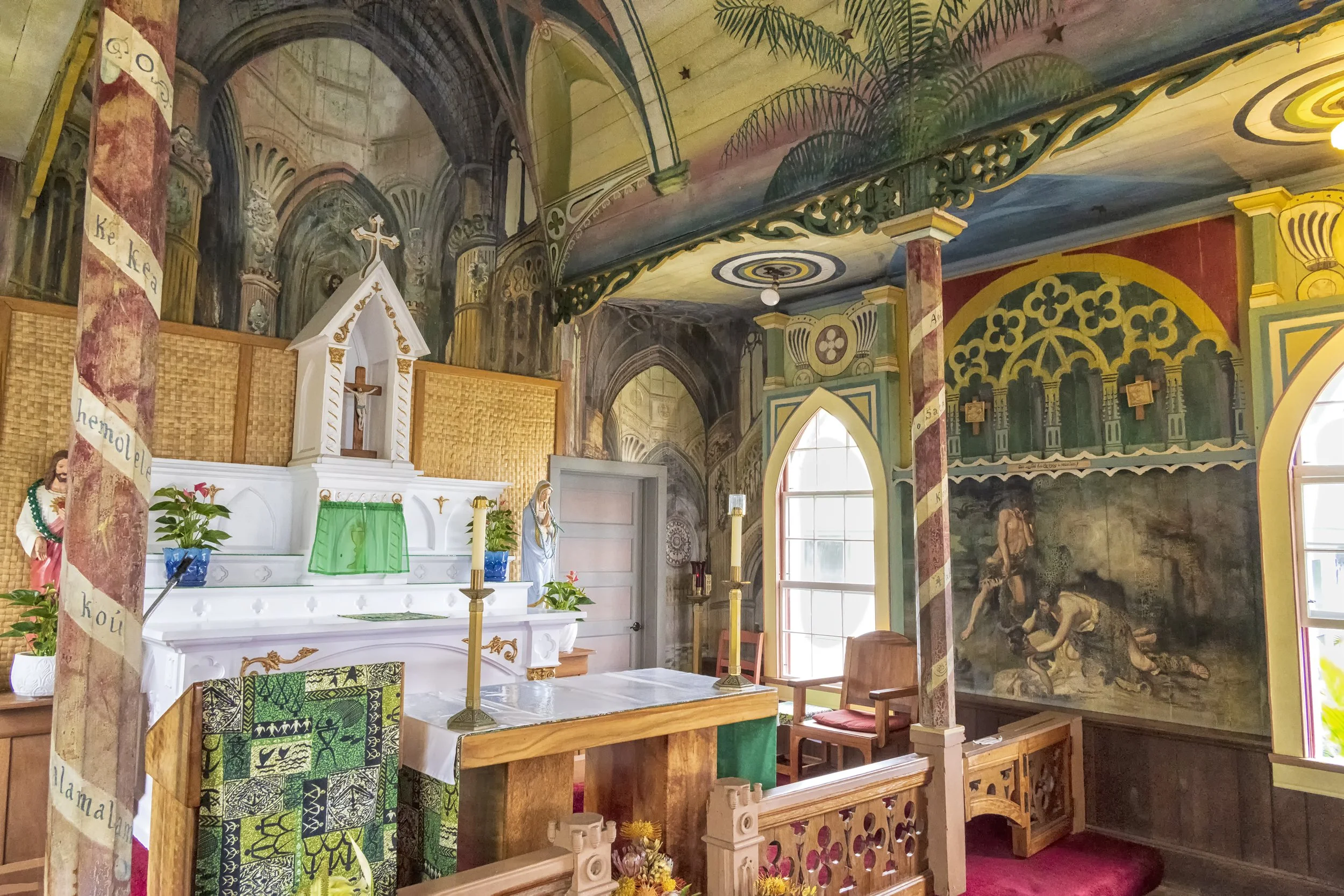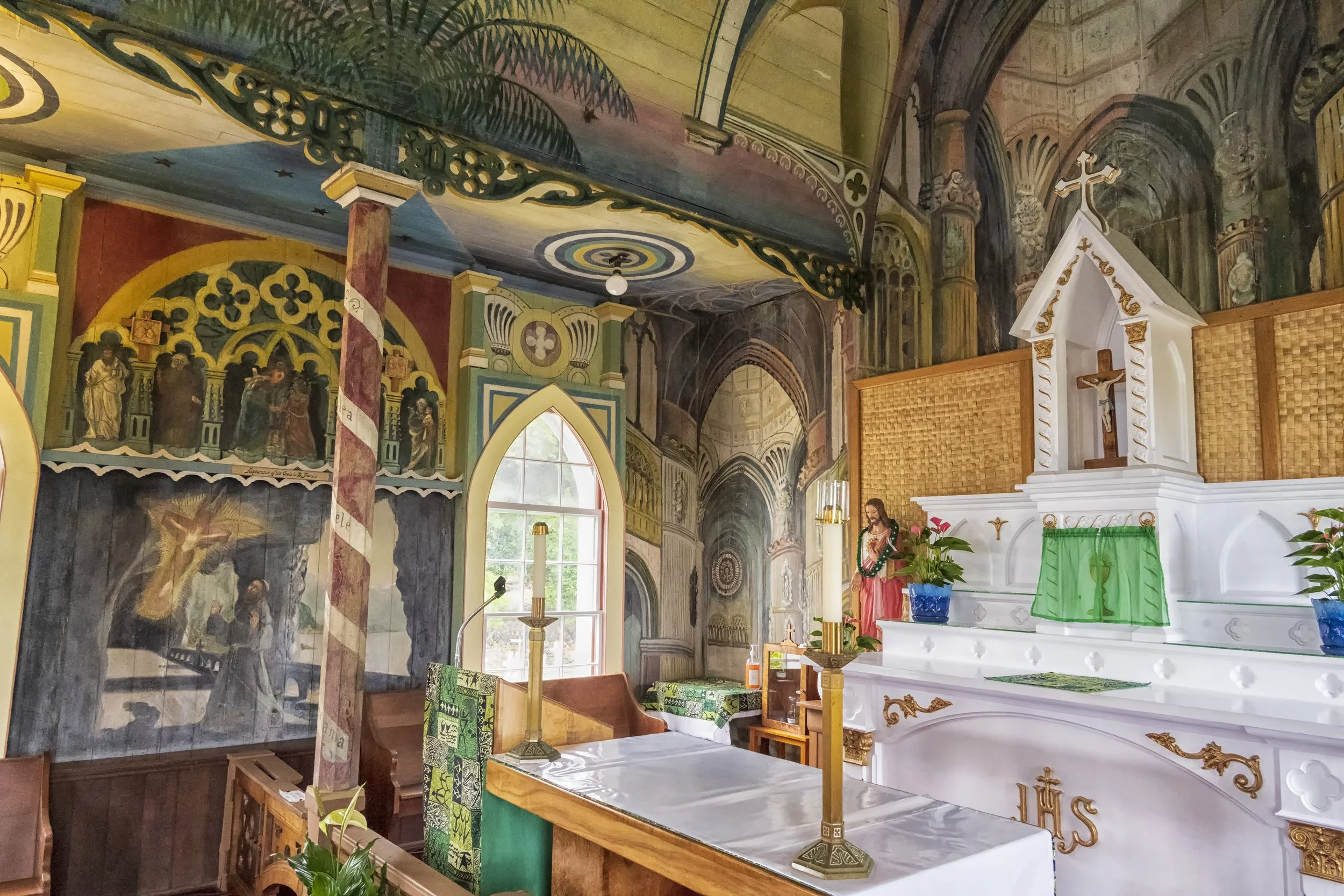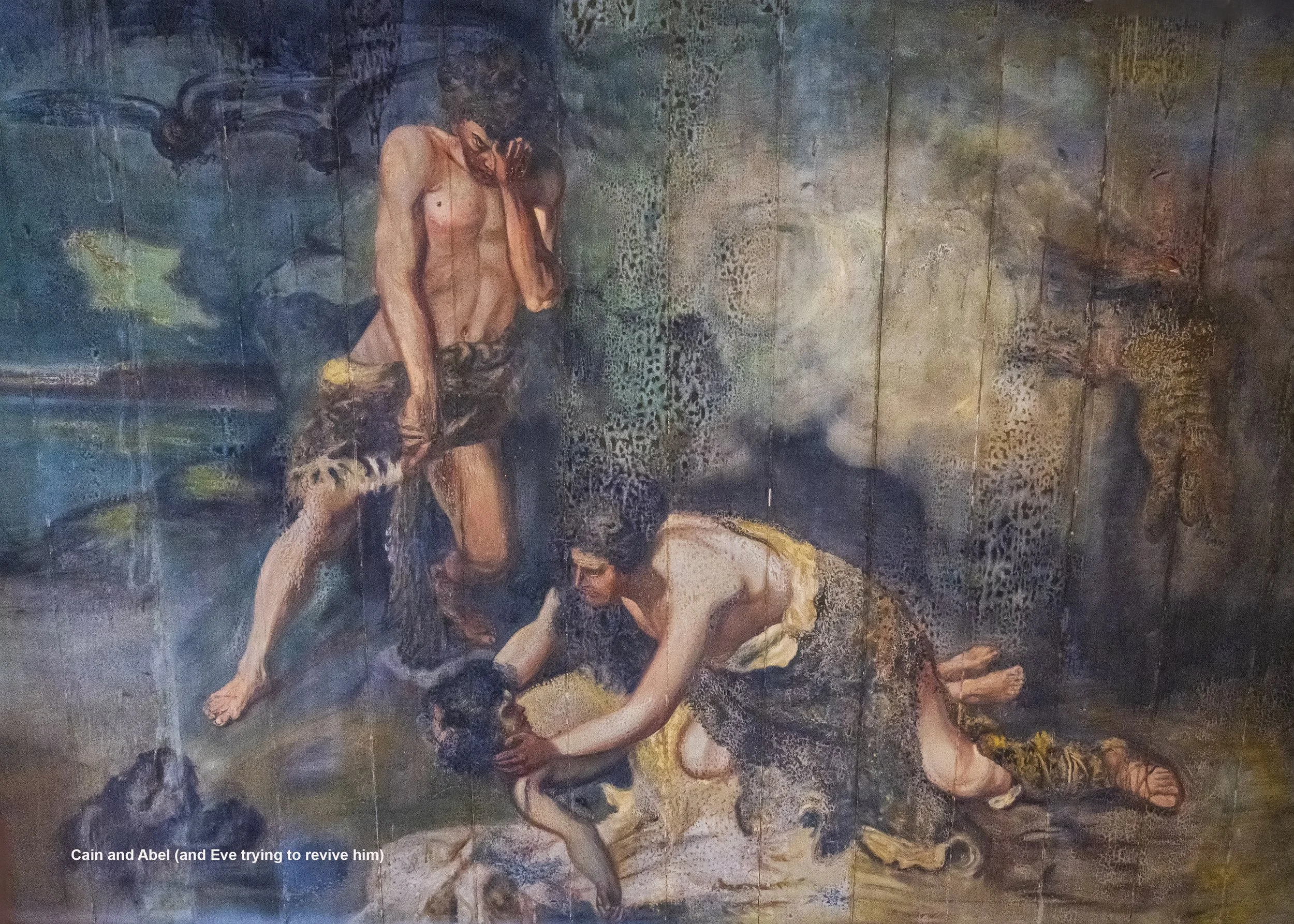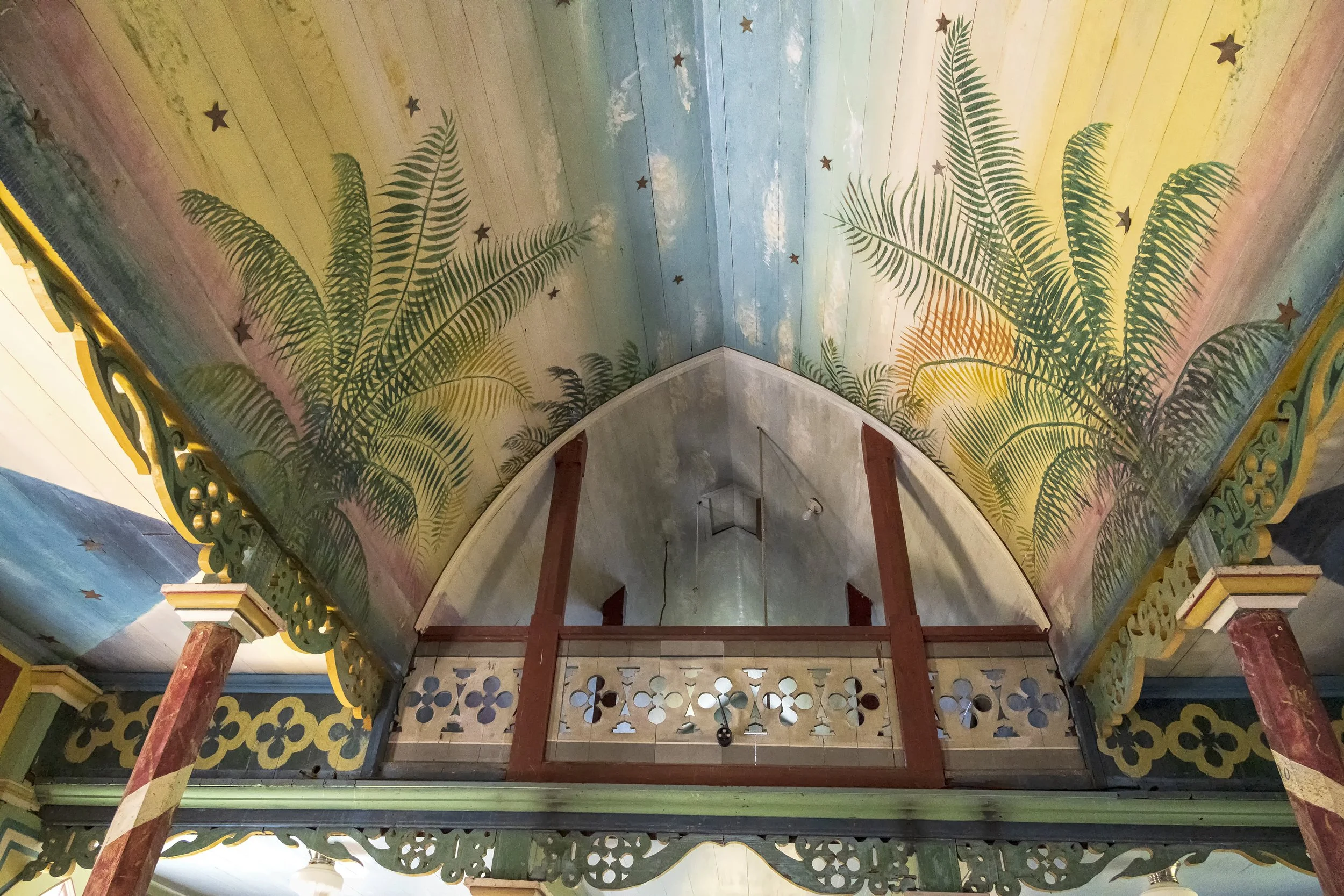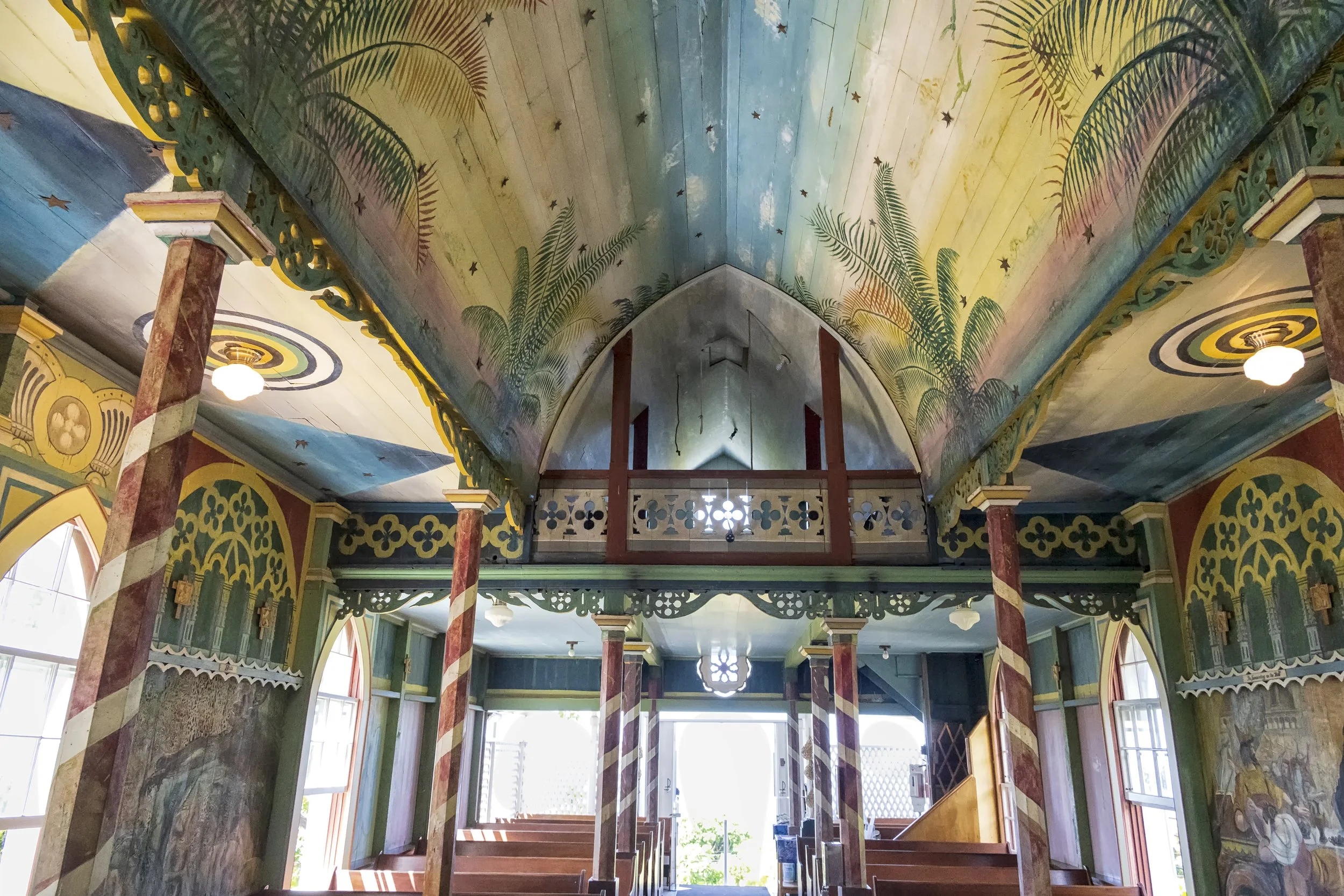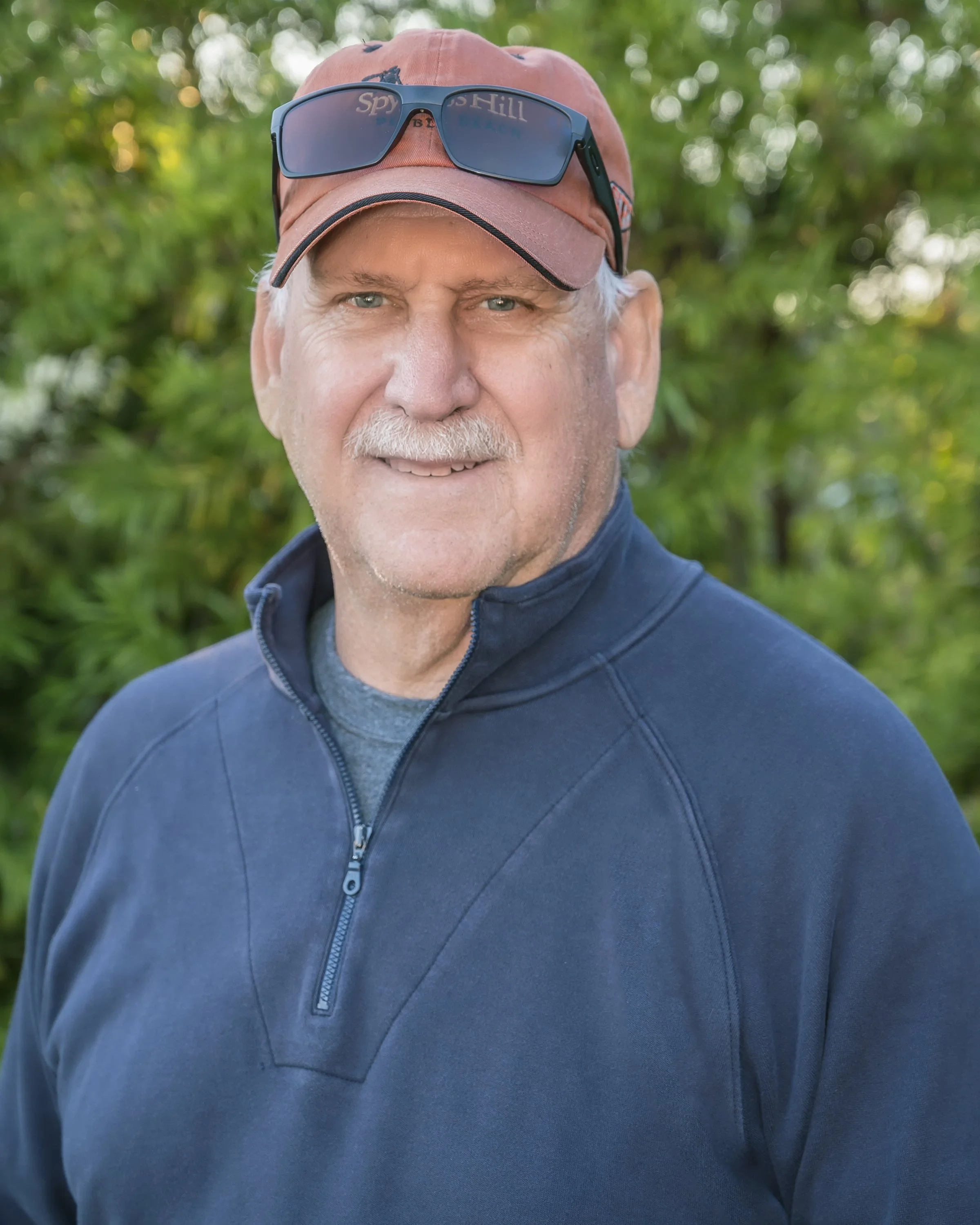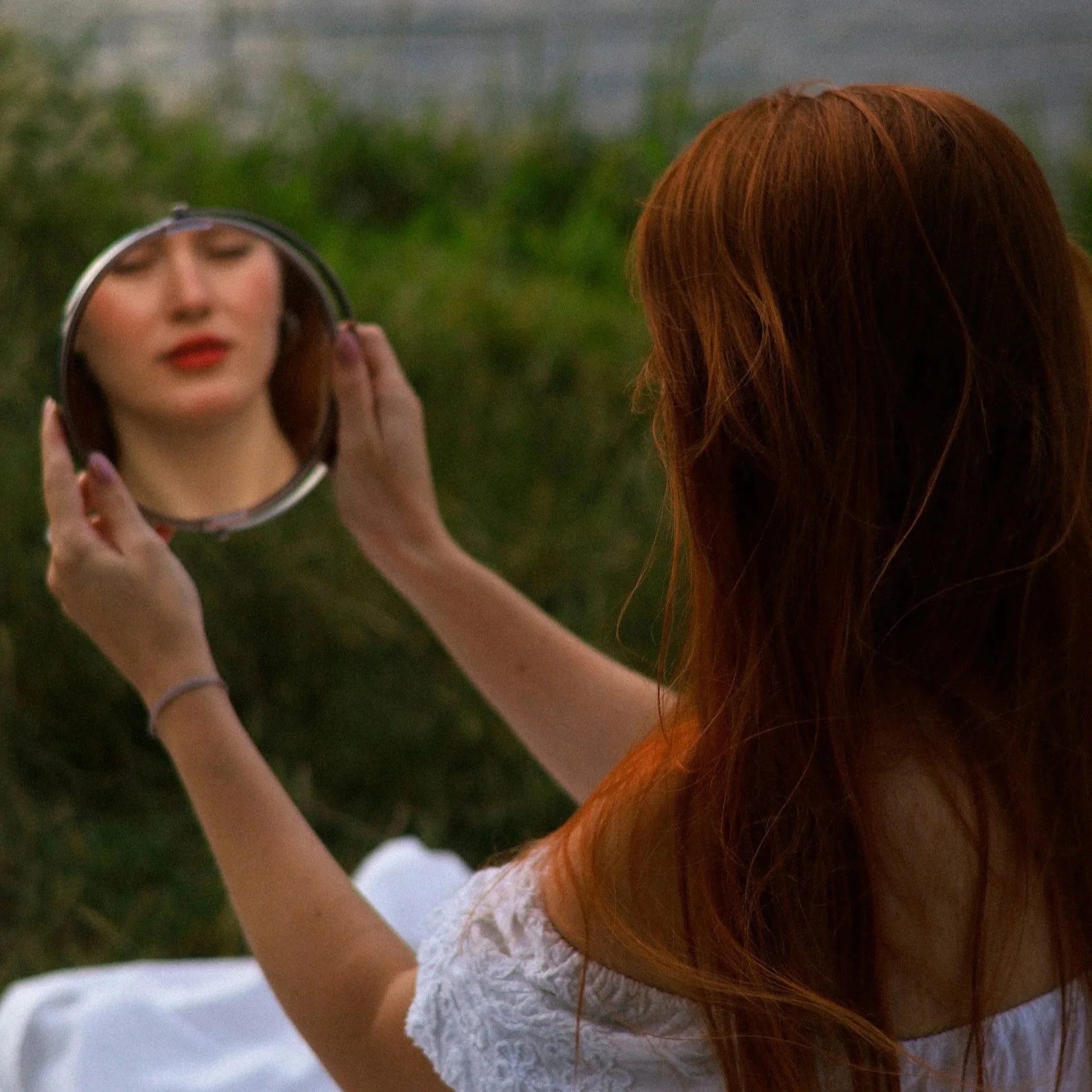The Soul Artist- Hawaii Island’s “Painted Church”- St. Benedict’s Catholic Church By Contributor and Photographer Steve Tabor
In the early 1800’s missionaries from Europe and the United States journeyed throughout the South Pacific islands attempting to convert their native populations to Christian beliefs. As the number of converts increased and more missionaries traveled to these remote regions, small churches began to populate the landscape of many South Pacific islands including the Hawaiian Island chain.
The churches were a simple design often mirroring small traditional church designs found in the United States, but they were built using native trees, stones and other natural resources. A few of these structures have been able to withstand the test of time and still remain active houses of worship. On the Big Island of Hawaii, Hawaii Island, examples of these historical churches can be found throughout each of the Island’s regions. Among the most colorful and memorable of these spiritual shrines is St. Benedict’s Catholic Church, “The Painted Church”, found nestled along the steep slopes in the village of Hōnaunau in the South Kona district.
The church’s beginnings date back to 1842 when Father Joachim Marechal was assigned to the island’s South Kona and Ka’u districts and established a church along the shoreline where the original village of Hōnaunau was located. In ancient Hawaiian history the village was considered a most sacred site and was known as Puʻuhonua o Hōnaunau, Place of Refuge.
In ancient Hawaiian history, the village contained a high priest whose status allowed him to provide absolution for anyone who broke any kapu, an ancient Hawaiian code of conduct that was often considered a threat to spiritual powers or theft of a spiritual force. Anyone who broke a kapu received a sentence of death. However, if they could evade their capturers and find their way to Hōnaunau, they could seek out the high priest and request absolution for their misdeed. After receiving absolution, they would remain in the village for a period of time and eventually be allowed to return to their village. The sacred grounds of Hōnaunau were so respected that in times of war or conflict, the area also served as a safe place for defeated warriors and those unable to protect themselves.
Fr. Joachim eventually completed the chapel and named it St. Francis Regis Chapel, in honor of the Jesuit priest who was granted sainthood in 1737. St. Francis Regis was known for his work with marginalized populations including victims of the plague, prostitutes and orphans.
Due to the limited number of priests on the island, a priest could not reside at the chapel on a full-time basis. The chapel remained opened and a small Catholic school was established through the dedicated service of a full-time catechist and a schoolteacher.
Following Fr. Joachim’s death in 1859, Fr. Aloys Lorteau was assigned to the South Kona region. Fr. Aloys was able to maintain a full-time residence in Hōnaunau until 1898. During the early years of Fr. Aloys’ tenure, the villagers depended on fishing and other aquaculture activities to sustain themselves. By the mid-1880’s, there was the realization that the slopes above the shoreline contained a rich fertile soil that made it an ideal region to maintain coffee farms and coffee production. As more and more villagers left the shoreline to establish coffee farms on the slopes two miles above the water, the population of the shoreline community around the chapel dwindled.
Fr. Aloys died in 1898 while being transported to Honolulu to receive medical attention. It was his death and the assignment of a newly ordained priest, Fr. Jean (John) Berchmans Velghe that would begin a new chapter in the church’s legacy and provide the chapel with its unique identity.
Fr. John was ordained in 1888 in Louvain, Belgium as a member of the Sacred Hearts of Jesus and Mary, also known as the Picpus Fathers (Arguably, the most notable member of the order was Fr. Damien, who was later cantonized as a Saint in the Roman Catholic Church for his service to the members of the leper colony on the island of Moloka’i). Originally, Fr. John was assigned to the Marquesas and remained there until concerns over tropical fever swept the region. He was originally transferred to serve as a missionary on the continent of South America, but with reports of a yellow fever outbreak on the continent, Fr. John was diverted back to the South Pacific region and soon found himself on the shores of the South Kona district.
Prior to arriving in the South Kona district, Fr. John realized he was not adequately prepared to communicate with the Hawaiian speaking population, so as he did while in Marquesas, he utilized his self-taught artistic skills to communicate with the villagers using drawings. The over time he developed his artistic skills and incorporated them in his daily life with the villagers.
It did not take long for Fr. John to realize that the majority of the population had relocated and created a thriving community two miles above the shoreline. As a result, the St. Francis Regis Chapel was no longer in a position to be a vital part of the community, so he decided that the chapel needed to be moved up slope in order to be integrated into the growing community.
Fr. John along with volunteers dismantled the structure and, using mule-drawn wagons, took a majority of the materials from the original chapel to its new location. The new structure closely matched the previous chapel, but Fr. John felt that the new chapel needed to create an environment that offered a greater sense of welcoming and peace to those that entered its doors. He was confident that his artistic skills could create such an environment, and hoped he could utilizes these skills to create a sense of protection from evil spirits and transform written scripture into colorful images that transcended any language barrier.
Fr. John began the reconstruction in 1899. He utilized the salvaged materials as much as possible in the new construction, but he needed to supplement his supplies with other natural materials found in the area. For the necessary roof support columns, Fr. John used the coconut palm tree trunks.
When it came time to paint the chapel, Fr. John sought out paint donations from the villagers. They responded by donating leftover supplies of white, green, and brown exterior house paint. Realizing these colors were not enough to create the colorful artwork in the chapel, Fr. John began experimenting with the pigments from local vegetation and other organic sources to create the spectrum of colors he needed to complete his vision.
Fr. John felt that it was important for those entering the chapel to not only feel welcome, but by entering the chapel they would be safe from any evil forces. Fr. John painted the coconut palm tree columns in an alternating red and white spiral pattern and inscribed each of the columns with a portion of a short a prayer that was translated into Hawaiian.
The prayer reads:
O ke kea hemolele ko’u malamalama
Hele oe pela I Santana
He poino kou mea I ninini mai ai
Aole o Satana ko’u alakai
Ua oki oe me kou mea pau wale
Nau mo e inu kou poino
Translated the prayer reads:
The Holy Cross be my light;
Let not the dragon be my guide.
Get behind me Satan!
Do not tempt me with your vanities!
The things you offer are evil.
Drink your own poison!
Fr. John created an interior design that incorporates simulated views of the natural environment surrounding the chapel, architectural embellishments, spiritual artifacts and icons, and above the altar, he recreated the Dome of Light from the Cathedral of Saint Mary in the City of Burgos, Spain.
To complete his vision, Fr. John incorporated two sets of panels on the north and south interior walls. The panels along the north wall include a depiction of the temptation of Christ and two scenes of the Christ being revealed to believers and non-believers. The panels on the south wall include three depictions of involving death, including Cain and Abel, Hell, and a spiritual death.
Following the completion of the construction in 1902, the chapel was rededicated as St. Benedict’s Catholic Church in honor of the European monk who is credited with developing the prescribed lifestyle of monks in the Roman Catholic Church which included liturgical prayer, theological study, manual labor, and living together in a community under a common abbot. Over time the chapel became known as the “Painted Church”. Fr. John remained at the church until he began to experience some health issues which made it necessary for him to return to Belgium in 1904. Fr. John resided in various monasteries administered by the Sacred Hearts in Europe until his death in 1939.
For over one hundred years, St. Benedict’s remains an active house of worship and visitor attraction. The church’s original steeple was replaced, and other structural repairs have been made in order to maintain the facility. As far as the original artwork, it has not undergone any restoration or repairs since its installation. Even today, the panels and other artwork remain in remarkably good condition. The colors remain vibrant and show only minor signs of aging. Many attribute this to the paint which at the time was manufactured with lead and many other substances that are banned for use in today’s paints. The only panel showing more notable signs of deterioration is the panel entitled, “Hell”. So far, no one has been able to provide an explanation for the dramatic deterioration of the panel especially considering that the two other murals in close proximity on the same wall show only small signs of deterioration.
There is no doubt that Fr. John left the village of Hōnaunau with an extraordinary house of worship which found its way onto the State of Hawaii Register of Historical Places and the National Register of Historic Places. Through his sole efforts and self-taught artistic skills along with gallons of donated paint, Fr. John transformed a simple turn of the century house of worship into a sanctuary that speaks to the hearts and stirs the souls of everyone who crosses its threshold.
Fr. John Returns to Europe
When Fr. John returned to Belgium, he continued to pursue his passion for painting. Fr. John created a reproduction of set paintings entitled “The Seven Sorrows of Mary” that were created by Belgian artist, Joseph Janssens. The reproductions remain on display at the Church of St. Anthony in Louvain, Belgium.
Between the period of 1924-1926, Fr. John was teaching at Sacred Hearts’ Apostolic Church in Aarschot, Belgium where a young Matthias Gielen was attending. Eventually, Gielen would receive his holy orders and became a priest who chose Saint Evarist as his namesake. After his ordination, Fr. Evarist was assigned to oversee churches at Mountain View and Kalapana near the City of Hilo on Hawaii Island. During his assignment he used his artistic skills to create a similar house of worship, Star of the Sea, Painted Church. It also remains open to worshippers and visitors daily.
A special thanks:
Gwen McKinney for sharing information about St. Benedict’s Catholic Church’s history.
Steve Tabor Bio
This South Bay native’s photographic journey began after receiving his first 35 mm film camera upon earning his Bachelor of Arts degree. Steve began with photographing coastal landscapes and marine life. As a classroom teacher he used photography to share the world and his experiences with his students. Steve has expanded his photographic talents to include portraits and group photography, special event photography as well as live performance and athletics. Steve serves as a volunteer ranger for the Catalina Island Conservancy and uses this opportunity to document the flora and fauna of the island’s interior as well as photograph special events and activities.
Watch for Steve Tabor Images on the worldwide web.


